|
Notes l Bibliography l Download Issue 11 
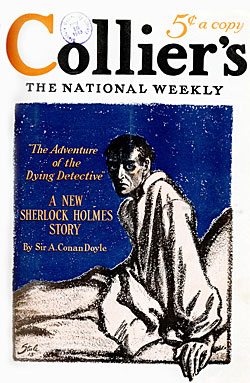 |
|
Frederic Dorr Steele created a cover and three other haunting illustrations for Collier's Weekly's version of "The Dying Detective" (November 22, 1913) |
Mrs. Hudson, the landlady of Sherlock Holmes, was a long-suffering woman. Not only was her first-floor flat invaded at all hours by throngs of singular and often undesirable characters, but her remarkable lodger showed an eccentricity and irregularity in his life which must have sorely tried her patience. (1)
Mrs. Hudson does not appear prominently in the Holmes canon. This story and "The Empty House" both feature her taking action on Holmes's behalf, outside of her duties as landlady—a rare event.
She was fond of him, too, for he had a remarkable gentleness and courtesy in his dealings with women. He disliked and distrusted the sex, but he was always a chivalrous opponent. (1)
Holmes's distrust of women and his simultaneously "chivalrous" manner illustrate the deep contradiction in his character between his apparent lack of sympathy or feeling, and his ability to empathize—to put himself in another's place and imagine how the person would feel or act when confronted with a particular situation.
...in the second year of my married life.... (1)
Watson married Mary Morstan after the successful conclusion of The Sign of Four (written in 1890; set in 1887).
“...down at Rotherhithe, in an alley near the river....” (1)
"Rotherhithe" was the East-End neighborhood around the Surrey Commercial Docks, located east of London on the south bank of the Thames.
...a hectic flush upon either cheek.... (3)
"Hectic" means feverish, but can also refer to a fluctuating fever, as in chronic diseases like tuberculosis.
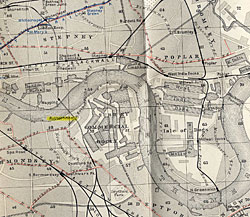 |
|
The name "Rotherhithe" can be seen in small print just west of the Surrey Commercial Docks. A tunnel connects Rotherhithe to the north bank of the Thames and the London docks. From Baedeker, London and its Environs (1911) |
“It is a coolie disease from Sumatra—a thing that the Dutch know more about than we, though they have made little of it up to date.” (3)
In 19th-century England, "coolie" was a derogatory term for an indentured worker from Asia. Later, the word became a racial slur, usually referring to Indian or Chinese people.
Sumatra, the largest island in the Southeast Asian archipelago that lies entirely within the country of Indonesia, was a Dutch colony until 1945, when Indonesia declared its independence.
“What do you know, pray, of Tapanuli fever? What do you know of the black Formosa corruption?” (3)
Both these dread diseases are fanciful terms concocted by Conan Doyle based on real place names. "Tapanuli" is part of northern Sumatra, and "Formosa" is the former name of the island of Taiwan, given to it by Portuguese sailors.
“...I wonder how a battery feels when it pours electricity into a non-conductor?” (5)
A battery cannot "pour" electricity into a non-conductor, since no current could flow through a substance that did not conduct electricity. Is Holmes making a remark about Watson's reluctance to do his bidding?
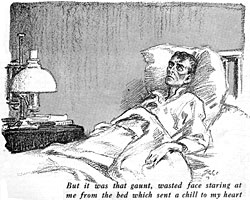 |
|
Holmes near death, drawn by Frederic Dorr Steele, Collier's Weekly |
“...of 13, Lower Burke Street.” (5)
The 1911 Baedeker guide lists no Lower Burke Street in London.
It was an old acquaintance, Inspector Morton, of Scotland Yard, dressed in unofficial tweeds. (6)
Inspector Morton turns up nowhere else in the Holmesian canon.
...in the vague borderland between Notting Hill and Kensington. (6)
Notting Hill and Kensington are districts lying west of Kensington Park Gardens and Hyde Park.
A high bald head had a small velvet smoking-cap poised coquettishly upon one side of its pink curve. (7)
The gentleman's smoking cap, a soft hat shaped like a fez, became a fad in England and France during the Crimean War (1854-56), in which England, France, and the Ottoman Empire fought Russia. Returning soldiers brought back cigarettes made from dark Turkish tobacco, along with the affectation of the embroidered smoking cap, which was only worn indoors. The original purpose of the smoking cap was to keep the hair from smelling like smoke, which is certainly a waste of fabric in Mr. Smith's case.
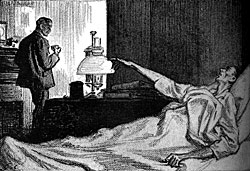 |
|
Holmes warns Watson away from the ivory box, drawn by Frederic Dorr Steele, Collier's Weekly |
The skull was of enormous capacity, and yet as I looked down I saw to my amazement that the figure of the man was small and frail, twisted in the shoulders and back like one who has suffered from rickets in his childhood. (7)
Holmes describes Mr. Smith metaphorically as a brilliant man whose other human qualities are stunted.
"Rickets" is a vitamin D deficiency that causes bone and joint malformations.
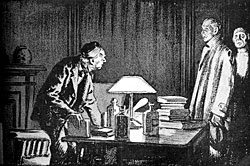 |
|
Watson meets Mr. Smith, drawn by Frederic Dorr Steele, Collier's Weekly |
“Among those gelatine cultivations some of the very worst offenders in the world are now doing time.” (7)
Gelatin is used as a medium to cultivate bacteria, which feed on the organic material.
“...he has been working among Chinese sailors down in the docks.” (7)
The London docks (on the River Thames) were moved east of the city proper in the early 19th-century. Covering an area of more than 30 acres, the docks were dismal and crime-ridden. Indentured Chinese sailors and dockworkers were treated little better than slaves, and, like other poor Londoners, were susceptible to diseases that prey on poorly-nourished people living in close quarters.
“Coals of fire, Holmes—coals of fire!” (8)
"Therefore if thine enemy hunger, feed him; if he thirst, give him drink: for in so doing thou shalt heap coals of fire on his head" (Romans 12:20).
“It was very essential that I should impress Mrs. Hudson with the reality of my condition, since she was to convey it to you, and you in turn to him. You won't be offended, Watson?” (11)
Holmes trusts no one's acting ability but his own. As always, the case, not hurt feelings, is paramount in Holmes's mind, and he believes that the friends he offends should feel that way, too. Watson often feels that Holmes is keeping something from him. This example from a late story illustrates Watson's reluctant acceptance of the fact that Holmes will never allow him the intimacy of old friends, no matter how long they know each other.
He was recovering fast, and I had suspicions at times that he was really finding himself faster than he pretended even to me. There was a curious secretive streak in the man which led to many dramatic effects, but left even his closest friend guessing as to what his exact plans might be. He pushed to an extreme the axiom that the only safe plotter was he who plotted alone. I was nearer him than anyone else, and yet I was always conscious of the gap between.
From "The Illustrious Client" (The Strand, March 1925)
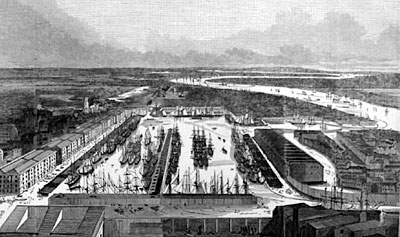 |
A bird's-eye view of the London Docks in 1845, from the Illustrated London News (Wikipedia Commons) |
“...belladonna in one's eyes....” (11)
Belladonna, or deadly nightshade, has a long history of use as a cosmetic. It is a deadly poison, used in small doses as a homeopathic remedy; dropped in the eyes in diluted form, it causes the pupils to dilate and the heart rate to increase. Continual use causes blindness.
“...poor Savage, who stood between this monster and a reversion....” (11)
A "reversion" is an agreement whereby a piece of property is owned by one person during his lifetime, with the understanding that ownership "reverts" to another person or his heirs after the first person's death.
“That pretence I have carried out with the thoroughness of the true artist.” (11)
Holmes sees himself as an artist, and has the capacity to be insufferably pleased with himself after a success.
“...something nutritious at Simpson's would not be out of place.” (11)
Simpson's-in-the-Strand, located at 100, The Strand, opened as a restaurant in 1848, and still serves traditional English cuisine: steak and kidney pie, potted shrimps, game (in season), and treacle sponge pudding. It is certainly the perfect setting in which to imagine Holmes and Watson, ordering oysters as they relax at a corner table after some great adventure.
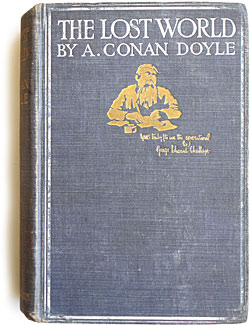 |
The original cover of The Lost World bears the image of Conan Doyle masquerading as the outspoken Professor Challenger, accompanied by a taste of his characteristic rudeness: "Yours truly, to use the conventional lie. George Edward Challenger." |
In June 1922, during Conan Doyle's lecture tour of the United States, Harry Houdini invited him and his wife Jean to the annual banquet of the Society of American Magicians. As master of ceremonies, Houdini intended to demonstrate some tricks of fraudulent mediums. Wary of being publicly humiliated for his spiritualist beliefs, Doyle at first refused. After some coaxing, he accepted, but brought along a trick of his own.
The banquet was attended by famous magicians, who performed their best tricks. Houdini and his wife Bess did their spectacular "Metamorphosis" trick, in which Houdini quickly escaped from bonds, a bag, and a locked trunk, only to reveal Bess, just seconds later, confined as he had been. That night, Bess was wearing Sir Arthur's overcoat when she exited the trunk.
When his turn came, Conan Doyle set up a movie projector. "These pictures are not occult," he said by way of introduction, "but they are psychic, because everything that emanates from the human spirit or human brain is psychic." After this cryptic remark, he showed the magicians something astonishing: moving pictures of live dinosaurs walking, eating and fighting. Everyone was mystified. To an audience unaccustomed to movies with special effects, a preliminary clip from The Lost World by Watterson R. Rothacker, the 1925 movie version of Conan Doyle's novel, must have seemed inconceivable. The next day, Conan Doyle wrote a letter to Houdini, with copies to the press, revealing the source of his strange film.
With the advent of "talking" pictures in 1927, many silent films were destroyed by the studios. The Lost World was reconstructed in 2002 from a few spare reels and a 35mm copy discovered in Prague. It is currently available on DVD.
|








